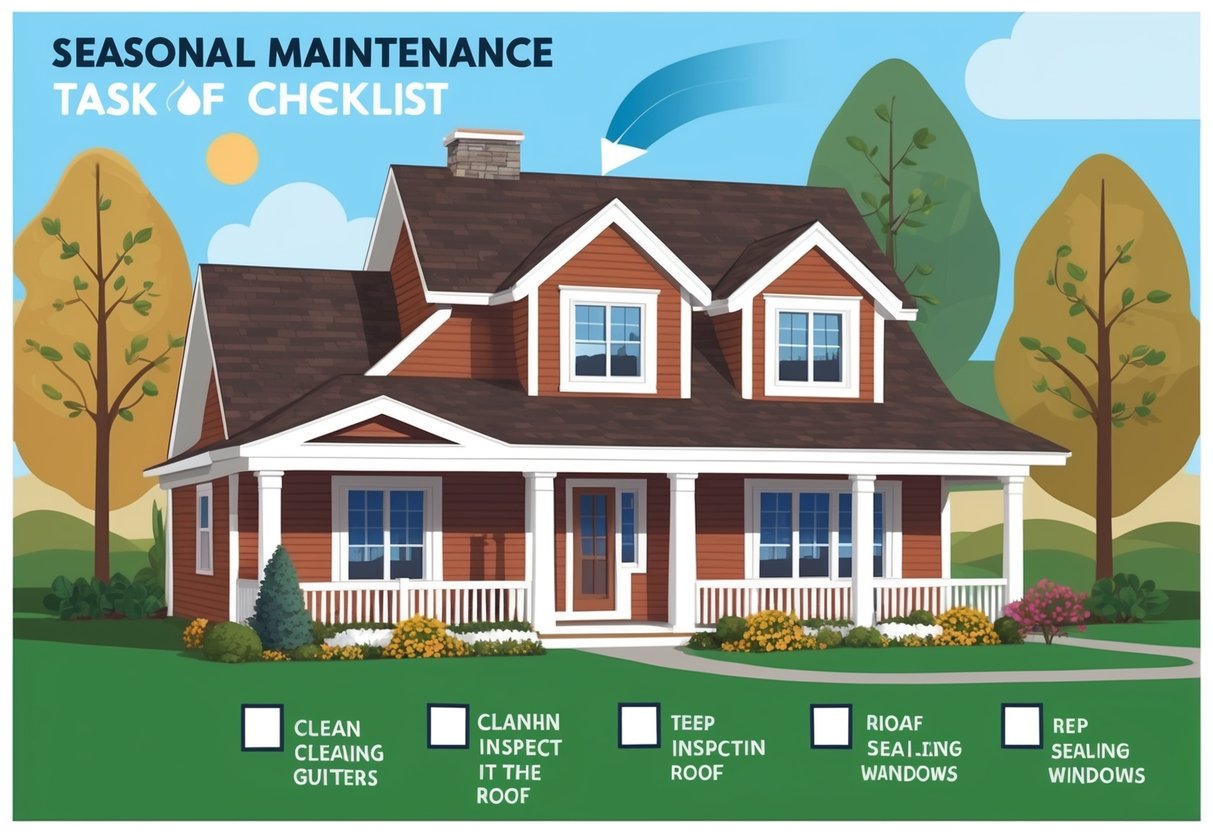
Owning a home can come with unexpected expenses, but many of these can be avoided with proactive upkeep. Regularly following a seasonal home maintenance checklist is one of the most effective ways for homeowners to prevent costly repairs and extend the life of their home’s key systems.
Simple actions like cleaning gutters, checking the roof for damage, or changing the HVAC filter can have a big impact on both safety and savings.
Staying ahead of potential issues helps keep everything from the foundation to the roof in better condition year-round. Experienced homeowners know that planning routine inspections and maintenance tasks for each season is crucial to maintaining property value and enjoying worry-free homeownership.
Those looking for an organized plan can consult resources such as this ultimate home maintenance checklist to help stay on track with essential tasks.
Neglecting regular upkeep can lead to bigger problems and higher repair bills down the road. By taking a few hours each season to focus on preventative care, homeowners can create a safer, more comfortable living environment while protecting their investment for years to come.
Understanding the Importance of Regular Home Maintenance
Regular home maintenance is a proactive way to minimize unexpected expenses, safeguard property, and create a secure living environment. Staying on top of maintenance allows homeowners to reduce repair costs, increase comfort, and maintain the value of their investment.
Financial Benefits of Preventative Care
Preventative care helps avoid major home repairs that tend to be more expensive when problems are left unaddressed. Routine maintenance—such as cleaning gutters, checking for leaks, and servicing HVAC systems—prevents minor issues from turning into costly emergencies.
By investing in regular upkeep, homeowners can extend the lifespan of appliances and infrastructure. For example, replacing air filters, inspecting roofing, and resealing windows are small tasks that can save thousands in the long run.
According to USA Wire, home maintenance protects your investment by stopping small issues from escalating. This approach also supports efficient energy use, reducing monthly utility bills and preventing expensive breakdowns.
Protecting Structural Integrity
Preserving a home’s structural integrity depends on consistent inspections and timely repairs. Water intrusion, foundation cracks, and damaged roofing can threaten the entire structure if not addressed promptly.
Regular checks of the basement, attic, and exterior walls can reveal early warning signs. Paying attention to signs like water stains, rotting wood, or shifting doors ensures that potential threats to the home’s foundation are identified early.
As highlighted by HomeSmiles, proper maintenance prevents small problems from becoming significant structural repair projects. This reduces the risk of devaluation and keeps the property safe and sound throughout every season.
Improving Home Safety
Routine home maintenance improves safety for everyone living in the home. Critical tasks include testing smoke detectors, inspecting electrical systems, and servicing heating equipment to limit fire and carbon monoxide risks.
Trimming overgrown landscaping, repairing loose steps, and checking for trip hazards help prevent injuries. Keeping walkways clear and maintaining exterior lighting are simple steps that support a secure living environment.
Consistent attention to safety measures ensures that emergencies, such as electrical fires or slip-and-fall accidents, are less likely. According to Independence Home Life, regular maintenance not only protects the home’s systems, but also increases day-to-day comfort and peace of mind.
Creating a Seasonal Maintenance Schedule
An effective seasonal maintenance schedule helps homeowners prevent expensive issues by spreading tasks throughout the year. Keeping a structured approach allows essential checks and repairs to happen on time, instead of letting problems build unnoticed.
Establishing a Yearly Maintenance Checklist
Creating a comprehensive home maintenance checklist is the first step in setting up a successful maintenance schedule. Homeowners should identify tasks required for every area of the property, from roofs and gutters to HVAC systems, plumbing, and safety equipment.
Categorizing tasks as monthly, quarterly, or yearly helps prioritize actions based on season and urgency. A clear checklist makes it easier to stay consistent.
Items might include inspecting roof shingles each spring, servicing the HVAC system before summer, and checking insulation ahead of winter. Several checklists for every season offer useful guidance, covering routine care and preventive measures to protect the investment in a home.
Organizing Tasks by Season
Dividing home maintenance tasks into seasons ensures attention to what matters most at specific times of year. Spring tasks focus on recovery from winter, such as cleaning gutters, inspecting siding, and checking outdoor faucets.
Summer might involve servicing the air conditioning, trimming trees, and inspecting pest control. Fall tasks usually prepare the home for colder months, like sealing gaps, checking heating systems, and cleaning chimneys.
Winter tasks tend to center on preventing freezing pipes, monitoring indoor humidity, and inspecting attic insulation. Using a seasonal guide not only simplifies planning but also protects against weather-related damage.
Tracking Completed Tasks
Keeping track of completed home maintenance tasks is crucial for homeowners aiming to stick to a yearly maintenance schedule. Using a simple table, a dedicated app, or a printable chart makes it easy to record when tasks were finished and by whom.
This prevents duplicate work and helps spot missed jobs before they turn into costly repairs.
| Task | Completion Date | Notes |
|---|---|---|
| HVAC Service | 04/14/2025 | Changed filter |
| Gutter Cleaning | 05/01/2025 | Debris cleared |
| Roof Inspection | 03/10/2025 | No damage found |
Digital tools or printable PDF checklists allow sharing progress with household members or contractors. This record-keeping ensures accountability and provides a clear maintenance history that is useful for insurance claims and future home sales.